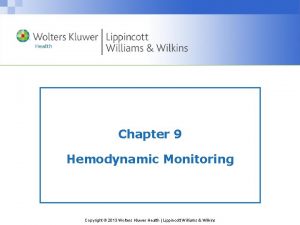Chapter 5 Neoplasia Copyright 2013 Wolters Kluwer Health



























- Slides: 27

Chapter 5 Neoplasia Copyright © 2013 Wolters Kluwer Health | Lippincott Williams & Wilkins

Cell Growth • Growth categories – Labile – Stable – Permanent • Growth regulators – Proto-oncogenes – Tumor suppressor genes – Apoptosis regulating genes – DNA repair genes Copyright © 2013 Wolters Kluwer Health | Lippincott Williams & Wilkins

Neoplastic Growth Malignant Benign • Slow growth • Expands into tissues, usually encapsulated • Cells are well differentiated. • Do not metastasize • Variable growth rate, depends on the level of cell differentiation • Invades surrounding tissues by infiltration, not encapsulated • Undifferentiated cells may not resemble cells of origin. • Metastasizes to distant tissues Copyright © 2013 Wolters Kluwer Health | Lippincott Williams & Wilkins

Neoplastic Growth (cont. ) Benign Malignant Copyright © 2013 Wolters Kluwer Health | Lippincott Williams & Wilkins

Carcinogenesis • Defined • Most common targets for genetic damage – Proto-oncogenes – Tumor suppressor genes – DNA repair genes – Apoptosis regulating genes Copyright © 2013 Wolters Kluwer Health | Lippincott Williams & Wilkins

Carcinogenesis (cont. ) • Etiology of genetic damage (carcinogenic agents) – Inherited traits/influences – Chemicals – Environmental insults/agents – Viral infections – Immune system defects Copyright © 2013 Wolters Kluwer Health | Lippincott Williams & Wilkins

Local Growth and Distant Metastasis • Local growth – Carcinoma in situ – Local spread • Mechanical pressure, enzymes, lack of adhesion • Metastasis – Lymph system – Blood system – Seeding Copyright © 2013 Wolters Kluwer Health | Lippincott Williams & Wilkins

Diagnosis • Symptoms • Screening – Physical exams (visual/palpation) – Radiographs (mammography) – Pap smear – Oral screening devices (brush biopsy and others) • Laboratory • Biopsy – Excisional/incisional – Aspiration Copyright © 2013 Wolters Kluwer Health | Lippincott Williams & Wilkins

Diagnosis (cont. ) • Benign – Well differentiated – No extension into or fixation to surrounding tissues – No metastasis • Malignant – Variable levels of differentiation (anaplasia) • Atypical cells – Extend into and are fixed to surrounding tissues – Lymph node and distant metastasis Copyright © 2013 Wolters Kluwer Health | Lippincott Williams & Wilkins

Anaplastic Changes Copyright © 2013 Wolters Kluwer Health | Lippincott Williams & Wilkins

Tumor Grading and Staging • Cancer grading – Level of differentiation • Systems – UICC—TMN – AJCC—TNM/anatomic stage/prognostic groups • Molecular diagnosis • Molecular profiling Copyright © 2013 Wolters Kluwer Health | Lippincott Williams & Wilkins

Systemic Effects • Paraneoplastic syndromes – Fever – Anorexia – Endocrine imbalances – Anemia – Thrombocytosis – Hypercoagulability – Neurologic problems Copyright © 2013 Wolters Kluwer Health | Lippincott Williams & Wilkins

Cancer Therapies • Surgery • Radiation therapy • Chemotherapy • Hormone/antihormone therapy • Immunotherapy • Targeted therapy • Complementary and alternative therapies Copyright © 2013 Wolters Kluwer Health | Lippincott Williams & Wilkins

Side Effects of Therapy Mucositis • Anemia • Leukopenia • Xerostomia • Others Copyright © 2013 Wolters Kluwer Health | Lippincott Williams & Wilkins

Prevention • Stop the use of tobacco products. • Proper nutrition • Eat a variety of fruits and vegetables every day. • Reduce the amount of refined grains and sugars consumed. • Reduce the amount of high-fat red meat consumed. • Maintain a healthy weight throughout life. • Stay physically active. • Limit alcohol consumption. • Limit sun exposure, use sunscreen or other protection. Copyright © 2013 Wolters Kluwer Health | Lippincott Williams & Wilkins

Oral Metastatic Cancers • Metastatic cancer from any primary cancer site – Breast, lung, prostate, renal cell, and colorectal cancers most likely • Mandible more commonly affected than maxilla • May be the first sign of cancer in 30% of cases • Usually presents as poorly defined radiolucent defects – May cause pathologic jaw fractures – Paresthesia of associated soft tissues is common. • Be suspicious of this type of lesion in patients with a history of cancer Copyright © 2013 Wolters Kluwer Health | Lippincott Williams & Wilkins

Oral Metastatic Cancers (cont. ) Copyright © 2013 Wolters Kluwer Health | Lippincott Williams & Wilkins

Skin Cancers • Basal cell • Squamous cell • Melanoma Copyright © 2013 Wolters Kluwer Health | Lippincott Williams & Wilkins

Basal Cell Carcinoma • Etiology—UV light, genetic factors • Epidemiology—most common form of skin cancer (approximately 80%) • Pathogenesis—UV exposure causes accumulation of genetic defects over time; lesion exhibits slow growth. • Characteristics—most found in head and neck area, appears nodular with depressed center and rolled pearly borders often with capillaries seen throughout the border area Copyright © 2013 Wolters Kluwer Health | Lippincott Williams & Wilkins

Basal Cell Carcinoma (cont. ) Copyright © 2013 Wolters Kluwer Health | Lippincott Williams & Wilkins

Squamous Cell Carcinoma • Etiology—UV light, burned areas, genetics, EBV, and HPV • Epidemiology—second most common skin cancer (approximately 20%) • Pathogenesis—begins in keratinocytes of outer dermis, has a prolonged in situ stage, may metastasize in @2% of cases • Characteristics—painless, nonhealing, rough, red scaly papule that eventually becomes ulcerated and crusted as it enlarges Copyright © 2013 Wolters Kluwer Health | Lippincott Williams & Wilkins

Squamous Cell Carcinoma (cont. ) Copyright © 2013 Wolters Kluwer Health | Lippincott Williams & Wilkins

Breast Cancer • Epidemiology—almost 300, 000 women and 2, 000+ men will be diagnosed with breast cancer in 2011. • Most occur in upper outer quadrant of the breast and around the nipple. • Local lymph node involvement usually begins in axial nodes; may extend to nodes around the clavicle and sternum. • Common metastatic sites include lungs, kidneys, liver, adrenal glands, ovaries, bones of the spine, ribs, pelvis, and skull, including the maxilla and the mandible. • 70 to 80% are estrogen receptor positive. Copyright © 2013 Wolters Kluwer Health | Lippincott Williams & Wilkins

Risk Factors Associated with Breast Cancer Box 5. 8 RISK FACTORS ASSOCIATED WITH BREAST CANCER Factor Details Age The risk of breast cancer increases with age Race More whites are affected than blacks, but more blacks die from the disease Previous history of breast cancer There is a 3 to 4 times greater risk of breast cancer in the opposite breast after having cancer diagnosed in one breast Previous history of other hormone-associated cancers Ovarian and endometrial cancer are examples of other hormone-associated cancers that increase the risk of having breast cancer Family history of breast cancer Breast cancer in one primary relative (mother, sister) increases risk; two or more relatives with breast cancer increases that risk even more Genetic predisposition Some 5– 10% of breast cancers are known to be associated with the BRCA 1 and 2 genes Estrogen and progesterone exposure Early menstruation, late menopause, and the use of hormone replacement therapy increase a woman’s overall exposure to estrogen, women who had their first pregnancy after age 35 or those who never had a full term pregnancy Lifestyle factors Obesity, lack of physical activity, and more than 1 or 2 alcoholic drinks per day have all been associated with an increased risk of breast cancer Radiation High doses of ionizing radiation such as radiation therapy for other cancers that place the breast in the radiation beam increase the risk for breast cancer in that breast. The use of tanning beds and x-rays may also increase risk Copyright © 2013 Wolters Kluwer Health | Lippincott Williams & Wilkins

Prostate Cancer • Risk factors—age over 65 and African American descent • Approximately 250, 000 cases in 2011, second leading cause of death in men • Early detection – PSA – Physical examination Copyright © 2013 Wolters Kluwer Health | Lippincott Williams & Wilkins

Lung Cancer • Leading cause of death in both men and women • Tobacco smoke is the #1 risk factor. • Symptoms are usually ignored until the disease has progressed to an advanced stage. • Small cell carcinoma may present with Cushing syndrome –like symptoms. • All stages combined 1 year survival rate 43% • Diagnosed in early stage 5 -year survival rate 53% Copyright © 2013 Wolters Kluwer Health | Lippincott Williams & Wilkins

Colorectal Cancer • Risk factors: increasing age (90% over 50), family history, IBD, smoking, inactivity, obesity, type 2 diabetes, etc. • Associated with colorectal polyps and disorders such as FAP and Peutz-Jeghers • Suggest a referral if the patient presents with melanotic macules and other signs of GI problems • 5 -year survival rate if caught early is 90%. Copyright © 2013 Wolters Kluwer Health | Lippincott Williams & Wilkins
 Wolters kluwer health
Wolters kluwer health Wolters kluwer health
Wolters kluwer health Wolters kluwer health
Wolters kluwer health Lippincott williams & wilkins
Lippincott williams & wilkins Wolters kluwer health
Wolters kluwer health Wolters kluwer health
Wolters kluwer health Wolters kluwer health
Wolters kluwer health Wolters kluwer health
Wolters kluwer health Wolters kluwer health lippincott williams & wilkins
Wolters kluwer health lippincott williams & wilkins Edgar lopategui corsino
Edgar lopategui corsino Wolters kluwer
Wolters kluwer Wolters kluwer
Wolters kluwer Wolters kluwer
Wolters kluwer Wolters kluwer
Wolters kluwer Chapter 25 assessment of cardiovascular function
Chapter 25 assessment of cardiovascular function Virchow's triad
Virchow's triad Wolters kluwer pronunciation
Wolters kluwer pronunciation Wolters kluwer
Wolters kluwer Chapter 48 skin integrity and wound care
Chapter 48 skin integrity and wound care Wolters kluwer
Wolters kluwer Wolters kluwer
Wolters kluwer Wolters kluwer
Wolters kluwer Wolters kluwer ovid
Wolters kluwer ovid Wolters kluwer culture
Wolters kluwer culture Wolters kluwer pronunciation
Wolters kluwer pronunciation Clinical features of neoplasia
Clinical features of neoplasia Neoplasia
Neoplasia Patologia
Patologia


















































